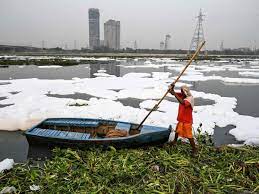Express View on Yamuna status report: River abandoned
In January, the National Green Tribunal (NGT) constituted a panel headed by Delhi’s lieutenant governor to find ways to rejuvenate the Yamuna in the capital. Six months later, a status report submitted by the Delhi government shows that there’s scarcely any reduction in the river’s pollution levels. It lists a litany of problems that have been known for long: The city’s sewage treatment plants do not operate to their full capacity and untreated or partially treated sewage flows into the river. A large number of localities, inhabited by the poor, are not covered by the network of pipes that take sewage to treatment plants. As a result, the water of the river in most of its stretch in the capital is not fit for bathing quality. The six-month deadline set by the NGT to resolve these problems was perhaps unrealistic. But in the past two decades, goalposts on Yamuna cleaning have been shifted several times. The Delhi government must get its act together.
The status report points to an “extension of the sewerage network to a few more unauthorised colonies and JJ clusters”. However, the fact that 245 million gallons of sewage is left untreated every day shows that this extension has not made much difference to the Yamuna’s pollution levels — by all accounts, about 250 MGD was dumped in the river before the NGT’s intervention. An interceptor drain project initiated more than 15 years ago has missed several deadlines. The idea behind the project was that, instead of laying a massive network of new lines, interceptor sewers would be laid to trap the sewage from Delhi’s three large drains that carry most of the city’s filth and dump it into the Yamuna. However, since the project was conceived, the number of colonies outside the city’s sewerage network has increased. It seems that the interceptor drain project did not plan for the impact Delhi’s growing population would have on the capital’s waste disposal system. The trouble also is that the different authorities in the city — the DDA, the municipal corporation, and the pollution control agencies — rarely work in sync. And, the Yamuna cleaning work is among the several casualties of the constant confrontation between the Delhi government and the city’s LG.
The Delhi stretch is only 2 per cent of the river’s length. But more than 70 per cent of the Yamuna’s pollution burden originates in the capital. Restoring the river in Delhi is, therefore, critical for its health. The NGT has asked the Delhi government to submit another report by September. The solutions have been known for long now. It’s high time they are implemented.
